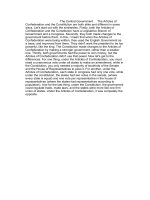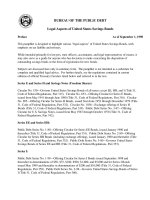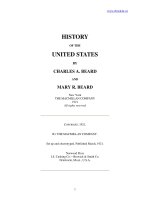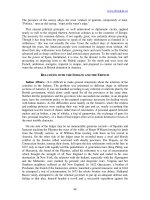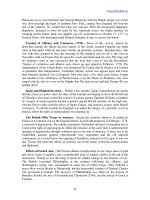CULTURE OF UNITED STATES
Bạn đang xem bản rút gọn của tài liệu. Xem và tải ngay bản đầy đủ của tài liệu tại đây (818.72 KB, 23 trang )
UNITED STATES
1. Information about 13 original states of US
The original thirteen colonies were Connecticut, Delaware, Georgia, Maryland,
Massachusetts, New Hampshire, New Jersey, New York, North Carolina, South Carolina,
Pennsylvania, Rhode Island and Virginia.
Facts of the Thirteen Colonies
Delaware: 1st state 12-7-1787; Delaware's Blue Hen army (named for their leader's pet fighting
Blue Hen rooster) turned away advancing British in initial skirmish with great speed and bravery;
the 13-star flag was flown in battle here first
Pennsylvania: means Penn's Woods, named for William Penn; nickname Keystone State because it
is the center of the arch of thirteen colonies; 2nd state 12-12-1787; settled by various religious
groups who greatly enhanced colonial life with inventions such as the Conestoga wagon
New Jersey: Land was given to the Governor of the Isle of Jersey in the English Channel for this
colony; it would be the site of over 100 battles and skirmishes before the Revolution ended
Georgia: Last colony settled but was 4th to ratify Constitution and become state; named after King
George II
Connecticut: 5th to become a state 1788; settled by Puritans from assachusetts; state laws were
model for US Constitution; nickname is Constitution State
Massachusetts: Plymouth Rock home; became a state 2-6-1788; once had a carved wooden codfish
on the wall of the State House because codfish were a big state industry
Maryland: Named for Queen Henrietta Maria of England; Known for its valiant army; statehood 428-1788; part of state became Washington D C
South Carolina: once part of "Carolana" with NC; nickname Palmetto State because fortress of
palms kept British warship away from Charleston harbor in 1776 battle; statehood 5-23-1778
New Hampshire: named for Hampshire County in England; became state 6-21-1788; was heavily
explored by both French and English
Virginia: home to four of the first five US presidents, and eventually home to four more; site of 1st
permanent settlement in Jamestown 1607.
New York: Named for the Duke of York (brother of King Charles II); statehood 7-26-1788; US
Congress met here after Revolution
North Carolina: Home of Roanoke Island's Lost Colony; first child born in America was John
White's granddaughter Virginia on 8-18-1587; statehood 11-21-1789
Rhode Island: smallest colony and state; not an island, was maybe named for Isle of Rhodes in
Aegean Sea; 1st declare independence from England but last of thirteen to become a state because of
concerns over being fairly represented in spite of size
1. Virginia (1607) - Established by the London Company
2. New Jersey (1618) - Originally settled by the Dutch, but seized by the English in 1664.
3. Massachusetts (1620) - Founded as two colonies: Plymouth Colony (1620), settled by the
Pilgrims; and Massachusetts Bay Colony (1630), settled by the Puritans. They were united in
1691, and annexed Maine, which had been colonized by the New England Council in the
1620's.
4. New Hampshire (1622) - Originally part of Maine, then a colony from 1629 until annexed
by Massachusetts, 1641-1643. Became a separate colony again in 1679.
5. Pennsylvania (1623) - Originally settled by Dutch and Swedes. Came under English control
in the 1664 and was granted to William Penn by Charles II in 1681.
6. New York (1624) - Founded as New Netherland by the Dutch West India Company. Seized
by the English in 1664 and renamed.
7. Maryland (1634) - Granted to Lord Baltimore.
8. Connecticut (1635) - Founded by settlers from Massachusetts and other colonies. New
Haven Colony, founded by settlers from Massachusetts in 1638, annexed to Connecticut in
1662, when the older colony was granted a royal charter.
9. Rhode Island (1636) - Settled by two groups from Massachusetts and united in 1644.
Chartered by King Charles II in 1663.
10. Delaware (1638) - Settled by Swedes; seized by the Dutch in 1655 and by the English in
1664. Granted to William Penn in 1682.
11. North Carolina (1653) - Settled by pioneers from other colonies. Carolina was separated
from Virginia and granted to a private company in 1663; divided into two colonies in 1711.
Made a royal providence in 1729.
12. South Carolina (1670) - Originally part of Carolina Colony. Was separated from North
Carolina in 1711, and became a royal providence in 1729.
13. Georgia (1733) - Granted to a private company by George II in 1732 and settled a year later
in Savannah.
50 states and one district of Columbia
Total area: 9,826,675 sq km (UK: 243,610 sq km; VN: 331,698 km2 dat lien)
Capital city: Washington D.C
Natural Resources: coal, copper, lead, molybdenum, phosphates, uranium, bauxite, gold, iron,
mercury, nickel, potash, silver, tungsten, natural gas… The US has the world’s largest coal reserves
with 491 billion short tons accounting for 27% of the world’s total.
Independence: 4 - 7 - 1776
Constitution: 17 - 9 - 1787, effective 4 - 3 - 1789
2. Flag Description
The national flag of the United States of America, often simply referred to as theAmerican
flag, consists of thirteen equal horizontal stripes of red (top and bottom) alternating with white, with
a blue rectangle in the canton (referred to specifically as the "union") bearing fifty small, white, fivepointed stars arranged in nine offset horizontal rows of six stars (top and bottom) alternating with
rows of five stars. The 50 stars on the flag represent the 50 states of the United States of
America and the 13 stripes represent the thirteen British colonies that declared independence from
the Kingdom of Great Britain and became the first states in the Union; the blue stands for loyalty,
devotion, truth, justice, and friendship; red symbolizes courage, zeal, and fervency, while white
denotes purity and rectitude of conduct; commonly referred to by its nickname of Old Glory.
Nicknames for the flag include the "Stars and Stripes", "Old Glory", and "The Star-Spangled
Banner".
3. History
- Virgina is the first colony
- George Washington is the first supreme commander
- Thomas Jefferson wrote Declaration of Independence in 1776
- Bill of Rights: is the collective name for the first ten amendments to the United States
Constitution. Proposed to assuage the fears of Anti-Federalists who had opposed Constitutional
ratification, these amendments guarantee a number of personal freedoms, limit the government's
power in judicial and other proceedings, and reserve some powers to the states and the public. While
originally the amendments applied only to the federal government, most of their provisions have
since been applied to the states by way of the Fourteenth Amendment, a process known
as incorporation.
The Bill of Rights enumerates freedoms not explicitly indicated in the main body of the
Constitution, such as freedom of religion, freedom of speech, a free press, and free assembly; the
right to keep and bear arms; freedom from unreasonable search and seizure, security in personal
effects, and freedom from warrants issued without probable cause; indictment by a grand jury for
any capital or "infamous crime"; guarantee of a speedy, public trial with an impartial jury; and
prohibition of double jeopardy. In addition, the Bill of Rights reserves for the people any rights not
specifically mentioned in the Constitution and reserves all powers not specifically granted to the
federal government to the people or the States. The Bill was influenced by George Mason's
1776 Virginia Declaration of Rights, the English Bill of Rights 1689, and earlier English political
documents such as Magna Carta (1215).
The Bill of Rights had little judicial impact for the first 150 years of its existence, but was
the basis for many Supreme Court decisions of the 20th and 21st centuries. One of the first fourteen
copies of the Bill of Rights is on public display at the National Archives in Washington, D.C.
Since the Bill of Rights was adopted more than 200 years ago, only 17 more amendments
have been added to the Constitution.
3.1. Early America
12,000 years ago: Human lived throughout Americas
1st Americans were from Asia, moving from Alaska toward the mainland
Different groups of people: Hohokam, Adenans, Hopewellians, Anasazi, but all disappeared.
The Hopi and Zuni (known as Native Americans) came and prospered
Europeans came: Different groups of explorers came and claimed parts of America their colonies.
1492: Christopher Columbus landed on islands in Caribbean Sea
1500s: Spain claimed land in Americas
3.2. Colonial period and the road to Independence
New World divided into 3 regions:
+ Northeast: New England, economy based on timber, finishing, ship building and trade
+ Middle: Industry and agriculture
+ Southern: Mostly farmers
Disagreements btw the royal governors and colonial assemblies
need for independence.
1774: 1st Continental Congress
1775: American Revolution: George Washington leads colonist Continental Army - fight against
British rule.
1776 July 4th: Thomas Jefferson’s American Declaration of Independence endorsed by Congress
- colonies declare independence
“We hold these truths to be self-evident, that all men are created equal, that they are
endowed by their Creator with certain inalienable Rights, that among these are Life, Liberty, and
the Pursuit of Happiness”
3.3. Forming a National government
1783: Britain accepted loss of colonies by virtue of Treaty of Paris
By 1788: 13 colonies became The United States, a nation of 13 countries.
By 1788: 13 colonies became The United States, a nation of 13 countries.
America bought Louisiana from France in 1803.
By 1837, new states had been created around the Mississippi.
By 1850, Oregon and California became states.
1843: One thousand people traveled to Oregon
1848: USA wins Texas in the Mexican War
1849: California gold rush
1862: A new law gave free land to settlers
By 1912, all states except Alaska and Hawaii had been created.
1787: Founding Fathers drew up new constitution for United States of America. emphasize
the significance of the Constitution. It begins with We the People: freedom/ equality. The
first time in the world: the final power belongs to the citizen of USA. The power is divided
into 3 branches.
1788: Constitution came into effect.
1775 George Washington was commander-in-chief of the Continental Army.
1789: first president of USA (1789 –1797)
1791: Bill of Rights guarantees individual freedom
1st amendment: freedom of religion, speech, press, right to assemble and petition
2nd amendment: right to bear arms
3rd amendment: no quartering of soldiers
4th amendment: no unreasonable searches and seizures of persons and property without probable
cause
5th amendment: no double jeopardy, right to remain silent…..
6th amendment: right to a speedy trial
7th amendment: guarantees a jury trial in civil cases
8th amendment: no excessive bails or fines and no cruel and unusual punishment
3.4. Civil war and post-war reconstruction
Reason: Conflict on slavery
The Battle of Antietam or Battle of Sharpsburg was fought on September 17, 1862, near Sharpsburg,
Maryland, and Antietam Creek, as part of the Maryland Campaign. It was the first major battle in
the American Civil War to take place on Northern soil. It was the bloodiest single-day battle in
American history, with about 23,000 casualties.
The first major battle on Northern soil
The bloodiest single-day battle in American history
23,000 casualties
1865
Civil War Ended, African Americans had more rights.
3.5. Growth and transformation
The 19th - 20th century was the century of great inventions and events
3.6. World War I, The Great Depression and World War II
In 1917
The war reached across the Atlantic Ocean to affect the United States
Oct 1929: Collapse of the stock market and economic depression.
1932
20% of Americans jobless
1941
• Japan attacked American fleet at Pearl Harbour, Hawaii.
• President Franklin Roosevelt: a "day that will live in infamy."
US declared war on Japan
1945: WWII ended - 50 million deaths
3.7. The Cold War, Korean conflict and Viet Nam
1947 – 1991: Cold War
1950 –1953: US intervened the war between N. Korea & S. Korea with support from UN.
US helped S. Vietnam against N. Vietnam but withdrew by 1973.
3.8. End of the 20th century
1. What was the name to the first set of laws written to govern the first 13 colonies?
-> Constitution
2. What is the name of the first ten amendments to the Constitution?
-> the Bill of Rights
3. What group would not approve the constitution unless it included the Bill of Rights?
-> 10 amendments are bill of rights: basic freedom.
However some groups were denied their freedom in the past. One of them is the Black. The civil
war started to end the slavery.
4. Life, Liberty, and the Pursuit of Happiness are considered what? -> Natural rights
5. What Enlightenment Thinkers influence the Declaration of Independence and the
Constitution?
The Enlightenment was an intellectual movement in Europe during 18th century in which ppl
began to change their views on the world and on society. The Enlightenment grew larely out of
the new methods and discoveries achieved in the Scientific Revolution of the 16th and 17th
centuries.
The Enlightenment Principles:
- Religion, tradition, and superstition limited independent thought
- Accept knowledge based on observation, logic, and reason, not on faith
- Scientific and academic thinking should be based on reasoning, not on Church
The Enlightenment:
- included a number of writers living at different times in various countries
- challenged old ways of thinking
- questioned divine-right of rule
- believed that social reforms were necessary and possible in this life, not just the next
The Enlightenment Thinkers: Voltaire, Thomas Hobbes, Rosseau, John Locke, Montesquieu
The American Enlightenment:
- Based on knowledge of classical writings
- Evolved at a time when ppl craved new knowledge and wisdom
- that craving inspired ppl to make new developments in science, religion and politics
- led to America’s independence and the principles of the American Government
- Through enlightenment ideals ppl began to think that a ruler had to be held higher laws
Enlightenment Thinkers of the American Revolution: Thomas Jefferson, Benjamin Franklin,
Thomas Paine
Enlightenment Shapes Independence:
- All men are created equal, that they are endowen by their Creator with certain unalienable
Rights, that among these are Life, Liberty, and the pursuit of Happiness
- Governments derive their power and authority from”the consent of the governed”
- When any government infringes upon individual’s rights, “it is the Right of the PPL to alter
or abolish it, and to institute new Government”
- Declared the colonies to be “Free and Independent States”
Enlightenment Shapes Government:
- Declaration of Independence - sought to promise personal freedom to all citizens
- New form of government - based on the ppl’s right to have a say
- enlightenment philosophers shaped the making the Constitution
- Montesquieu - the balance of power between 3 branches of government
- Rousseau - the power of democracy and consent of the ppl were in the formation of new
government
Enlightenment and the Rise of Democratic Ideas:
- Natural Rights -> Bill of Rights: Freedom of religion, freedom of Speech, Civil Rights
- Social Contract -> American Revolution - Declaration of Independence - Constitutions
- Separation of Power -> Checks and Balances
Enlightenment
Thomas Hobbs
Social contract -> Federalism
John Locke
Government for ppl - American Revolution - Natural Rights: life,
liberty, property - Declaration of Independence
Voltaire
Tolerance, reason, freedom of religion and speech - Bill of Rights
Montesquieu
Separation of Powers - Constitutions
Rousseau
Religious Freedom - Bill of Rights
4. Tourist attractions:
- Golden Gate Bridge, California
- Grand Canyon, Northern Arizona
- Hawaii Volcanoes National Park, Hawaii
- Lake Tahoe, situated where California and Nevada meet
- Mount Rushmore National Memorial, South Dakota
- Niagara Falls, North America
- Statue of Liberty, situated at the entrance to New York
- Yosemite National Park, lies in the heart of California
5. Economy
79.6%: service, 1.2% agriculture, 19.2% industry (VN: 38.7% service, 20.6% agriculture,
41.22% industry)
3 ingredients of economic system of US: natural resources (mineral resources, fertile farm
soil, extensive costlines, shipping access); labor with high quality which converts natural resources
into goods; managers who organizeand direct as efficiently as possible.
Traditional managerial structure in the US is based on a top-down chain of command;
authority flows from the chief executive in the boardroom who makes sure that the entire business
runs smoothly and efficiently, through various lower levels of management responsible for
coordinating different parts of the enterprise, down to the foreman on the shop floor. Numerous
tasks are divided among different divisions and workers.
>< Now: many enterprises are seeking more flexible organixation structures, especially in
high-technology industries that employ skilled workers and must develop, modify, and even
customize products rapidly -> many companies have “flattened” their organizational structures,
reduced the number of managers, and delegated more authority to interdisciplinary teams of
workers.
The American free enterprise system emphasizes private ownership. Private businesses
produce most goods and services, and almost 2/3 of the nation’s total economic output goes to
individuals for personal use (the remaining 1/3 is bought by government and business). The
consumer role is so great -> The US is sometimes charaterized as having a “consumer economy”
Global Financial Crisis (2007-2008): caused by the bursting of the US housing bubble
(2006) -> unemployment
Top 3 industries: oil and gas; retail, health care
Top 5 jobs: dentist, nurse, pharmacist, computer system analyst, doctor, translator and
interpreter
6. Education
US
VN
- Preschool:
Pre-kindergarten: at age 3 or 4
Kindergarten: at age 5
- Elementary school: 6 years
- Middle school: 2 years
- High school: 4 years
- Community college: 2 years
- College or university plus: 4 years
Pre-primary school: 3-5
Primary school: 5 years
Middle school: 4 years
High school: 3 years
Technical school: 2 years
College: 2 years
University plus: 4 years
Compulsory Shooling: ends by law at age 16 in 30 states, at age 17 in 9 states and at age18
in 11 statesplus the District of Columbia.
School Leaving: 2 basic school leaving certificates: the High School Diploma (awarded to
graduates of secondary school); and GED - General Educational Development Certificate (awarded
to adults who left school but then complete a special supervised study and examination program.
Age
Level of Study
US Grade
UK Year
3-4
Pre-school
Pre-kindergarten
Nursery school
5-10
Elementary/Primary School
Kindergarten
Year 1 - 6
11-13
Middle School
6 - 8th
Year 7 - 9
14-18
High School
th
9 - 12 (freshman - senior)
Year 10 - 13
US
VN
- About 3000 different colleges and universities
- No difference between college and university
- Difference between college and community
college:
+ Community college: 2 years -> Associate
Degree
+ College: 4 years plus -> Bachelor, Master and
Ph.D Degree
- about 210 universities
- College: 3 years -> Associate Degree
- University: 4 years plus -> Bachelor, Master
and PhD Degree
US
VN
- Public: 90 % >< Private: 10 %
- From elementary to high school:
+ Public: no tuition
+ Private: tuition
- From college pluc:
+ Public: low tuition
+ Private: higher tuition
- Public: 89% >< Non-public: 11%
- From elementary to high school:
+ Public: low tuition
+ Private: higher tuition
- From college plus:
+ Public: low tuition
+ Private: higher tuition
Not always but private school is better than public school
Private school is often high standard school
US
VN
- Choosing major by themselves
- Choosing major by negotiating with parents,
even by parents
- Take SAT test -> apply to suitable colleges After 3 high school years: attend graduation test
which require SAT score:
6 subjects: Math, Literature, Foreign Language
3 subjects: Math, Writing and English
(mostly English), and 3 more
- Can reduce time school by taking more credits - Take an university entrance examination
- Can reduce time school due to university’s
policy
US
- Active
- Free to raise ideas and opinion respectful
- Focus on solving problem and critical-thinking skills
- A large of extracurricular activities
- Learn how to compete successful
VN
- Quiet
- A little afraid of showing opinion in class
- Focus on testing
- Less extracurricular activities
- Learn for achieving academic offerings
US
- The monetary value of education
- Educating the individual
- Racial equality
- Multicultural education
VN
- Studious
- Venerated teacher
- Proper behavior
Kindergarten is the first year of primary/elementary school and is the equivalent to Year 1 in
the UK. Elementary schools provide instruction in the fundamental skills of reading, writing and
arithmetic, as well as history, geography, civics, crafts, music, science, health and physical
education. Foreign languages are often introduced in middle school. Under the "No Child Left
Behind’" policy, students also complete state exams in reading/language arts, maths and science in
Grades 3 – 8 and once at the high school level.
As students advance to middle/junior high school, the curriculum will likely become a bit
more flexible, including both required and elective classes. In required subjects such as maths,
English and science, students may be grouped in class sections based upon achievement. They may
also begin having a bit more flexibility in selecting elective classes in subjects, such as foreign
languages, band, home economics, chorus and art.
Although there is no national curriculum, the general content of the high school curriculum
across the country has many consistencies. The state will likely set a list of basic required courses
for high school graduation. These may include English, mathematics, foreign language, physical
education, art and/or music, general science, and social studies (a subject that combines history,
government and geography). However, students continue to have flexibility in choosing the level of
their classes and elective subjects with the assistance of their parents and a school guidance
counsellor. Many high schools will also have "tracks" for students wishing to attend a four-year
university, pursue a vocational or technical degree at a two-year college or enter the workforce
following high school.
Upon satisfactory completion of 12th grade and the state graduation requirements, the
student receives a "high school diploma".
Types of Schools
As in the UK, there are both state-funded (public) schools and privately-funded
(private) schools.
Public schools (state-funded) provide free education for students who live in the local area
and are funded by local taxes and funding from the state and federal governments. About 85-90% of
students in the US attend public schools.
Most commonly, students in the public school system will attend the local school assigned to
them by their school district. However, some districts provide magnet (specialised), charter and
international schools, to which students may apply. Due to this system, families often take into
account the assigned schools for particular neighbourhoods when choosing a new area in which to
live.
Although public schools are open to students at all educational levels, students may be
grouped in class sections (Advanced Placement, honours, vocational classes, etc.) based upon
achievement and post-graduation goals (for example, earning a bachelor's degree, attending a
community college, or entering the work force).
Private schools charge a fee for attendance and may have a smaller student population than
public schools. They are often governed by a private board and subsequently are often not subject to
regulations on curriculum or teaching qualifications set by the state. About 10% of students in the
US attend private schools.
Assessment
Unlike in the UK, there is no national curriculum, and therefore US schools do not prepare
students for national examinations such as the GCSEs, Highers, AS or A-levels. Rather students
work toward completing a high school diploma (the requirements for which are set by each state),
and are assessed for university entry based on GPA, class rank within the year group, rigour of
classes taken (AP, honours, regular) and admissions tests. Students are generally assessed
continually throughout the semester via a combination of tests, mid-term/final exams, essays,
quizzes, homework assignments, classroom participation, group work, projects and attendance. This
assessment culminates with a final "grade" for each course awarded at the end of the semester.
Marks can be given as letters (A+, A, B+, B, etc), or as numbers out of 100%. These grades are
averaged over the student’s high school career, resulting in a Grade Point Average (GPA). Students
may also receive a class rank, ranking his/her GPA amongst other members of his/her grade (year in
school).
Generally the student's parents are sent a "report card" indicating the grades earned in each
subject at the end of a quarter, semester or year. The student's overall academic history is recorded
in a transcript which is later requested by universities seeking to evaluate the student. A "transcript"
is an official document produced by the school listing the classes completed by the student, his/her
marks (grades), GPA (grade point average), class rank and/or academic honours.
7. American Holidays
7.1. New Year’s Day
7.2. Martin Luther King Day
7.3. Groundhog Day
7.4. Valentine’s Day
7.5. Washington’s Birthday
7.6 Easter
7.7. Earth Day
7.8. National Arbor Day
7.9. Mother’s Day
7.10. Memorial Day
7.11. Flag Day
7.12. Father’s Day
7.13. Independence Day
7.14. Labor Day
7.15. Columbus Day
7.16. Haloween
7.17. Veterans Day
7.18. Thanksgiving Day
7.19. Pearl Habor Rememberance Day
7.20. Christmas Day
8. Institution
Three Branches of the US Government: The Legislative, The Executive and The Judicial
The Legislative Branch (makes laws)
- Congress created by Article I, section1 of the
Constitution 1787
- The House of Representatives + Senate = Congress
- Power:
+ Legislative: make law, amend constitution
+ National defense: declare war, raise and maintain
armed forces, make rules for the military
+ Financial Policy: print money, collect taxes and
regulate commerce -> power of the purse
+ Investigation: oversees and investigate the
executive branch. E.g. power of removal: allowing
impeachment and removal of the president, federal
judges and other federal officers
Senate
- 100 members (2 -
House of Representative
435
elected
The Executive Branch (carries out laws)
The
- President power:
Judicial
+ Head of State: make treaties (with 2/3 consent of the
Branch
Senate); receive leaders of other countries; appoint
(evaluates
ambassadors to other countries.
laws)
+ Administrative power: Appoint the Heads of each Executive
Branch department; Convene Congress on extraordinary
occasions; Adjourn Congress; Fill in administrative vacancies
during Congressional recesses
+ Legislative power: Recommend legislation to Congress
+Veto; Take care that the laws be faithfully executed; Grant
reprieves and pardons for offences against the US
- Limits of presidential power: under the controll of
Congress; depending on public opinions
Vice President
members • Roles:
Cabinet
• Roles: advise the President on
from each state)
- term of office:
6-year
terms,
staggered
- Leader: Vice
President
- Qualifications:
30 years of age
and citizen for 9
years
(apportioned by population)
- 6 non-voting members (D.C,
Commonwealth of Puerto
Rico, and other territories of
USA)
- Term: 2 year terms
- Leader: Speaker of House is
the 2nd
in the line of
succession to the presidency.
- Qualifications: 25 years of age
and citizen for 7 years
- Power: Initiate impeachment
cases; Originate revenue bills;
Elect the President - In case of
electoral college tie; Time to
debate: limited within 1 hour
• Legislative
Process:
a
reprentative sponsors a bill ->
committee work for study > bill
on calendar: voted, debated or
amended -> simple majority,
moving to Senate -> Another
committee for study -> bill on
calendar: voted, debated or
amended -> simple majority ->
conference committee The
resulting bill: final approval
1. The President has 10 days to
sign or veto the enrolled bill.
2. Both houses may override
his veto by passing again with
at least 2/3 of each body voting
in favor.
Succession in
Presidency:
take over presidency if
the president resigns,
dies or is
impeached
and
removed from office
The President of the
Senate:
cast
the
decisive vote on the
event of a tie in the
Senate.
any subject he may require
• Composition of the Cabinet: The
Vice President + 15 Heads of
Executive Departments + 5
individuals have Cabinet rank
• Qualities for Cabinet Officers:
Not be a member of Congress or
sitting Governor.
• Selection of Cabinet Officers:
The President appoints Cabinet
Officers.
-> The Senate confirm or reject
• Selection of Vice based on a simple majority vote.
President:
Elected along with the
President
in
the
Electoral College
Election:
US Constitutions requirements for a
presidential candidate:
- At least 35 years old
- A natural born citizen of the USA
- A resident of the USA for14 years
Electoral Process
1. Step 1: Primaries and Caucuses
• A Caucus: select the best candidate (discussions+ votes)
• A Primary: vote for the best candidate representing them in the general election
• 2 main parties in the US: Democratic Party and Republican party
2. Step 2: National conventions (held in each party)
Select the final presidential nominee
Choose a running mate (Vice president candidate)
Campaign throughout the country to win general population’s support
3. Step 3: General election (Election day)
• "the first Tuesday after the first Monday in November,” People vote for: 1 president and 1
vice president
• Actually, people are voting for Electors
-> AN INDIRECT ELECTION
4. Step 4: Electoral college
The number of electors in each state: based on its representation in Congress.
The winner-take-all system.
Each elector casts 1 vote following the general election (the Election day)
The winner: the candidate gets >270 electoral votes (half of 538 – the total electoral votes)
General Votes - Electoral college Votes
• TIE IN VOTING (ELECTORAL COLLEGE)
• UNDER 270 VOTES
• HOUSE OF REPRESENTATIVES MAKE THE FINAL DECISION
• NEW PREDIDENT AND VICE PREDIDENT ARE INAUGURATED IN 20th,
JANUARY
Governments - The multi-layered government system
- Federal Government
- State Government
- City Government
- County Government
- Village and Town
City Government: Mayor - Council ; The Commission ; The City Manager
The Commission
•
•
•
Legislative & Executive
1 Mayor & other commissioners
Power is equal
The Judicial Branch: 2 court system in America
- State Court
- Federal Court
1. The Federal Courts
• Duties
- interpret the law
- determine the constitutionality of the law
- apply the law to individual cases
Justices and judges:
• Judicial officers : - justices in the Supreme court
- judges in the inferior courts
The City Manager
•
•
•
•
Management expertise
City manager plan
Draw up city budget
Supervise most departments
• Appointed by the President and confirmed by the Senate
• Each court : 1 chief judge, other judges and staff of employees
+ Chief judge: - has served the longest on the court
+Staff : court reporters, clerks, assistants
•
•
Term : life
Many judges spend time speaking, working in the community, teaching or writing in legal
journals
the three-tier Structure: Federal courts:
Supreme Court
Appelate Courts
Special Courts
13 Courts of Appeals
94 U.S District Courts
Trial Court
Jurisdiction:
Hear cases including :
• Both civil and criminal cases break the federal law
• Cases : - disputes under the U.S Constitution, the U.S government
- conflicts between states (citizens of states)
- conflicts between the U.S and foreign government
• Judicial review
Supreme Court:
Established by Consitution
Size determined by Congress
Power given by Constitution
The annual term:
- From the first Monday in October to early summer (late June or early July)
- Hear cases : Monday to Thursday
- In Washington, D.C
The Courts of Appeals:
• 12 regional Circuit Courts of Appeals and 1 U.S Court of Appeals for the Federal Circuit
• Numbers : - each court has from 6-28 judges but most have 10
to
15
judges
- one Chief judge : served the longest
• Judges : appointed by the President, confirmed by the Senate
• Term : life
•
Jurisdiction : appellate decisions decided by the district courts, the court of international
trade, the court of Federal Claims,…
The District Courts:
• Created by Congress
• 94 district courts
• Judge : - each court has at least 2 judges, the biggest district :
- nominated by the President, confirmed by the Senate
- lifetime term
• The only federal court with a jury
• Jurisdiction : hear both civil and criminal cases
24 or more
300.000 cases/year
The Special Courts:
1. The United States court of international trade
• Created by Congress in the Customs Court Act of 1980
• Previously called the United States Customs Court
• The courtrooms and officers are in New York City and in foreign countries
• 9 Judges :appointed by the President, confirmed by the Senate
• Term : life
• Jurisdiction : hear cases involving international trade and customs
2. United States court of Federal Claims – “the People’s court”
• Established by Congress in 1982
• Began in 1855 to advise Congress claims against the U.S government
• 16 judges – serve a 15-year term
• Deal with most claims for money damages against the U.S government, dispute over federal
contracts
3. Other courts
U.S Court of Appeals for the Armed Forces
U.S Court of Appeals for Veterans Claims
U.S Tax Court
U.S Court of Military Appeals
State Courts: When states were formed, each state created its own law and its own court system
1. The Small Claims court – civil court
• provide state citizens with low-cost option to resolve disputes
• Award money damages
- limit the amount of money damages: < $10000
• No attorney
• Cannot try criminal cases or family court matters
2. State trial court
• Appellate court for small claim court appeals
• Hear civil cases, state criminal trials, nonlitigation cases (family law, wills, probate) and
juvenile trials
• Some states divide into 2 types : lower and higher levels
3. The State court of appeals
• Hear appeals coming from the state trial court
4. The State Supreme court
• the highest appellate court for the state court system
• Select appeals to hear
• Grant a petition for review
Judicial process:
Checks and balances, or the separation of powers, is based upon the philosophy of Baron de
Montesquieau. In this system the government was to be divided into three branches of government,
each branch having particular powers.



